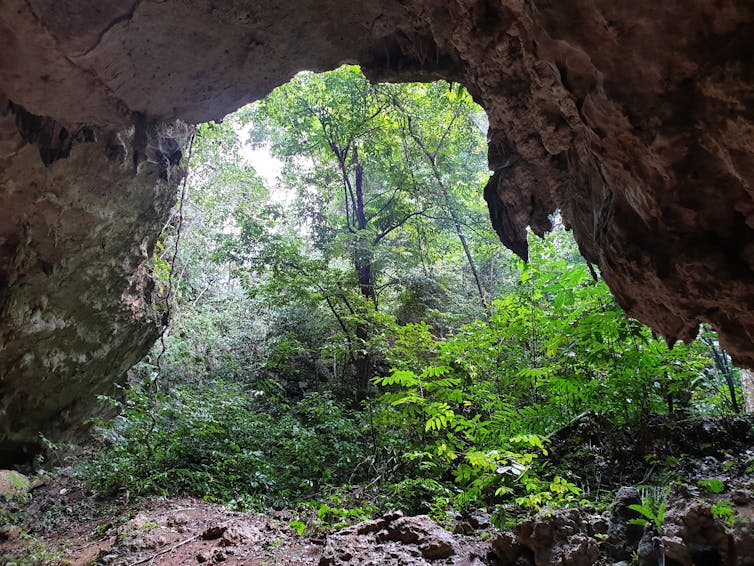Reading time: 5 minutes
Modern medicine seems to advance with time thanks to research breakthroughs. Hence it’s often thought that further into the past, only simpler medical practices existed.
The medical expertise of foraging communities such as hunter-gatherers has been thought to be rudimentary and unchanging. It’s been argued that shifts towards settled agricultural life within the past 10,000 years were what created new health problems and advances in medical culture; this includes surgery.
By Tim Ryan Maloney (Griffith University), Adam Brumm (Griffith University), Adhi Oktaviana (Griffith University), India Ella Dilkes-Hall (University of Western Australia), Maxime Aubert (Griffith University), Melandri Vlok (University of Sydney) and Renaud Joannes-Boyau (Southern Cross University)
Published today in the journal Nature, we report a discovery shattering this longstanding trope of popular imagination – the skeleton of a young adult from Borneo whose lower left leg was amputated in childhood by a prehistoric surgeon 31,000 years ago.

This finding pre-dates the previous oldest known evidence for amputation surgery by a staggering 24,000 years. It suggests that human medical knowledge and surgical procedures were far more advanced in the distant past of our species than previously thought.
The Borneo discovery
In 2018, some of the earliest known rock art was found in caves of East Kalimantan, Borneo, dating to 40,000 years ago.
The following year, archaeologists from Griffith University, University of Western Australia, and Indonesian institutions of archaeology and conservation (Arkeologi, Bahasa dan Sastra, Pusat Riset Arkeometri BRIN / Balai Pelestarian Cagar Budaya Kalimantan Timur) searched remote caves in dense rainforest for archaeological finds that could shed light on the lifeways of these early artists.

Led by local Dayak colleagues, the team travelled to a remote camp via a multi-day canoe and hiking journey. It was accessible only by boat at certain times of the year.
During these field trips, in early 2020 the team conducted archaeological excavation within Liang Tebo cave. There, they uncovered a complete human burial, with grave goods of brightly coloured red ochre pigments and stone burial markers.
Upon closer analysis of the leg bones of the remains, an unexpected discovery emerged.

Evidence for amputation at 31,000 years
Multiple dating techniques (radiocarbon, uranium-series, and electron-spin-resonance) confirmed the burial had taken place 31,000 years ago, making it Southeast Asia’s oldest known grave. Skeletal analyses confirmed the lower left limb had been surgically amputated; the way the bone tissue had changed over time (known as “bone remodelling”) matched clinical cases of successful amputation that hadn’t become infected.
The healed bone confirms an injury that wasn’t fatal to the patient, implying the surgeon or surgeons likely understood the need to manage and treat it. They were able to prevent infection after the invasive surgery, allowing the person to survive into adulthood.

Medical developments in tropical rainforests
In the tropical rainforests of Borneo, hot and humid conditions create the perfect breeding ground for various microbes, and therefore increase the chances of getting a wound infected. But the rainforests also have astonishingly rich plant species diversity. This vast “natural pharmacy” may have prompted early flourishing in the use of botanical resources.
The surgeons treating the amputation patient could have drawn upon locally available botanical resources before, during, and after the procedure. Such medicinal plants could have provided anaesthetics and antimicrobial remedies preventing infection.

Surviving a childhood amputation and living into adulthood among rainforest caves of Borneo also suggests a high degree of community care. A community that painted complex figurative art had also seemingly mastered the complexities of surgical amputation 31,000 years ago.
Sea levels being much lower at this time, Borneo was still connected to Asia. This means the survivor of this surgery also lived close to the potential departing shorelines of ice-age Asia, from where the world’s first mariners departed earlier still, eventually reaching what is now Australia.
This new finding adds to a growing body of evidence that the first modern human groups to reach our part of the world tens of thousands of years ago had medical knowledge and skills beyond what was previously thought.
This article was originally published in The Conversation.
Podcasts about prehistoric surgery
Articles you may also like

Call for Papers – Fighting to the Finish: Australia in 1945 – Strategy, Victory and Legacy Conference
Military History & Heritage Victoria is excited to announce the Call for Papers for our next conference – Fighting to the Finish: Australia in 1945 – Strategy, Victory and Legacy – which will be held on 11th October 2025 in Melbourne. History Guild is proud to support this conference. Keynote will be delivered by Emeritus […]

THE IMPACTS OF CORPORATE GLOBALIZATION: HOW THE DUTCH EAST INDIA COMPANY CHANGED THE WORLD
THE IMPACTS OF CORPORATE GLOBALIZATION: HOW THE DUTCH EAST INDIA COMPANY CHANGED THE WORLD The ‘Age of Discovery’, a period of European overseas exploration from the 15th to 17th century and considered by some to be the beginnings of globalization, is synonymous with the expansion of global capitalism and the explosion of maritime trade. At the start […]

How the Thirty Years War Affected Germany
Reading time: 4 minutes
The Thirty Years War (1618-1648) was a brutal conflict that saw most major European powers use Germany as a battleground to sort out their assorted dynastic, religious, economic and territorial issues. The toll this took on the country was massive, and reverberated for long after; let’s take a look at some of the damage it did.
The text of this article is republished from The Conversation in accordance with their republishing policy and is licenced under a Creative Commons — Attribution/No derivatives license.








